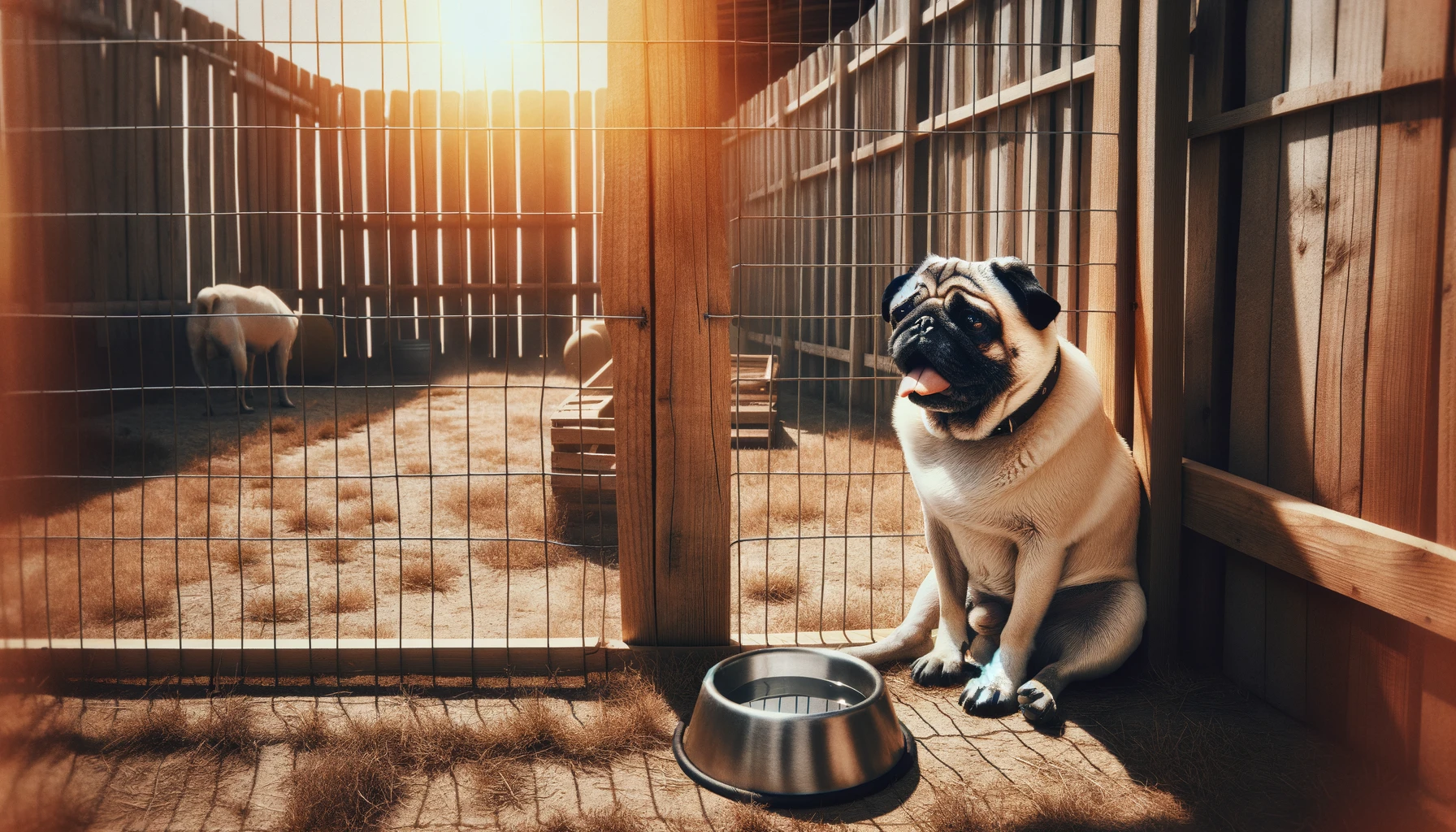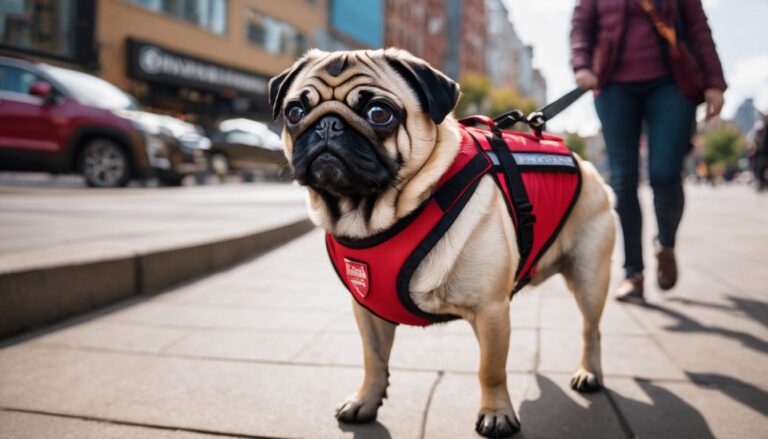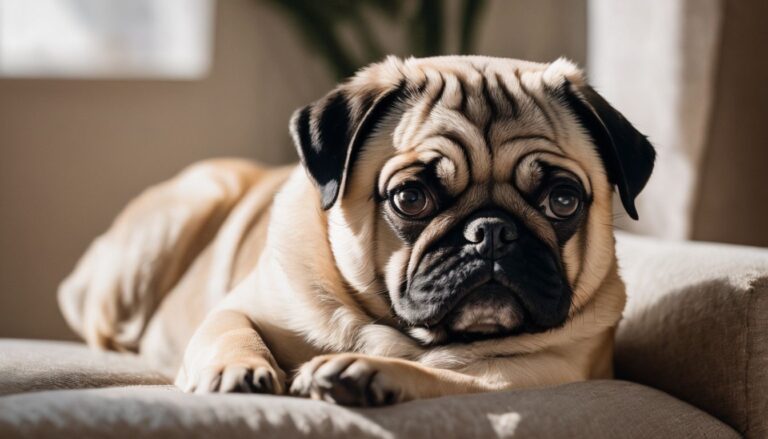Can Pugs Live Outside: Can the Beloved Breed Thrive Outdoors?
Can Pugs Live Outside?
I’ve always been intrigued by the adaptability of dogs, especially when faced with the question: “Can pugs live outside?” This query digs deep into the essence of pet care, reaching into the realm of understanding a dog breed’s specific needs and characteristics. Pugs, with their distinctive charm and quirky personalities, have nestled comfortably into the laps and hearts of many. Yet, the idea of transforming their plush indoor existence into an outdoor adventure sparks a wealth of considerations.
With pugs, it’s not just about a space to roam but understanding the delicate tapestry of their health issues, social needs, and the infamous pug intelligence that shapes their daily lives.
This exploration hinges on much more than preference; it’s about aligning with the core requirements of these affectionate companions.
Indeed, a nuanced approach is necessary, as diving into the world of pug puppy training, dog boredom solutions, and pet care unfolds a complex narrative over whether the beloved breed can truly thrive outdoors.
Key Takeaways:
- Understanding Requires Depth: Grasping a pug’s needs goes beyond surface-level care.
- Health is Paramount: Acknowledging pug health issues is crucial for their outdoor adaptability.
- A Heartfelt Connection: The bond with a pug informs the best environment for their well-being.
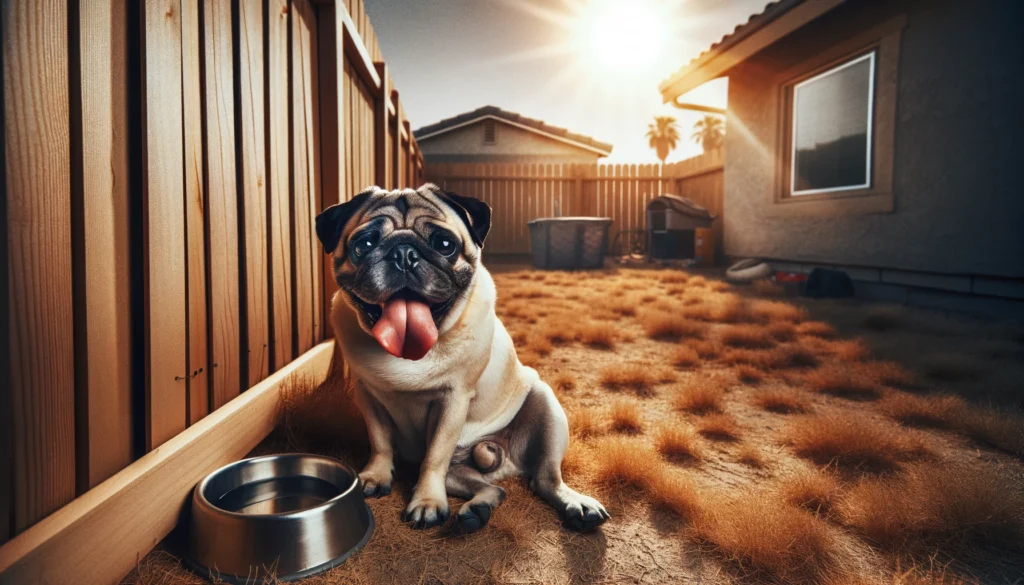
Can Pugs Live Outside – The Pug’s Nature
Pugs captivate us with their affection and charm, always yearning for constant companionship that reflects their deeply social nature. These small yet sturdy dogs are loving and loyal, with a need for attention that surpasses many other breeds. This characteristic raises questions about whether can pugs live outside, considering their adaptability to living outdoors.
Pugs face a myriad of health challenges, including respiratory issues and sensitivity to extreme temperatures, concerns that are magnified by their genetic makeup.
Given that this breed is so dependent on human interaction and vulnerable to environmental factors, the idea of them thriving outside seems precarious.
The complexities tied to their care, health, and emotional well-being make the concept of outdoor living for pugs a nuanced subject, requiring careful consideration of their specific needs against the lure of expansive, open-air environments.
Temperament and Social Needs
Pugs charm us with their affectionate personality, wrapping themselves around our hearts and demonstrating an unrivaled need for companionship. This breed craves attention and flourishes in the warmth of human interaction—not just as a preference but as a requirement.
Pugs show us that their place is right by our side, whether engaging in activities or simply enjoying quiet moments together.
Their sociable nature drives them to seek out affection, making the question of whether pugs can live outside far from straightforward. These dogs communicate in subtle ways that they were not meant to lead solitary lives in the backyard.
Instead, they thrive on being integral parts of our daily lives. Recognizing this, it becomes clear that the essence of pug socialization lies in the shared experiences and the bonds they form with us, their human companions.
Health and Genetic Considerations
Pugs charm us with their expressive faces and endearing personalities, but they carry a burden of health issues that stand at the forefront of concerns for pet parents pondering if pugs can live outside. Due to genetic faults, particularly in breeds like pugs, these little canines confront challenges.
Respiratory problems, a consequence of their distinct facial structure, question the prudence of allowing them to live outdoors. Their small size does not equate to fewer needs. In fact, the pug’s nature demands careful attention to weather extremes due to their susceptibility.
When debating the outdoor living suitability for a pug, one cannot overlook the health and genetic considerations. Their well-being centers on a stable, temperature-controlled environment, far from the harsh variations found outside.
Though their companionship is unparalleled, their physique may not support an outdoor lifestyle. Thus, ensuring they are safeguarded becomes imperative for those who treasure their affectionate gaze and spirited presence.
Respiratory Challenges
Pugs carry a unique set of health challenges, primarily centered around their respiratory system. Their distinctive face shape causes compressed nasal passages. This condition leads to breathing difficulties, especially under strain or in extreme weather. Outdoor environments can exacerbate these health concerns.
Hot climates pose a severe risk of overheating because pugs cool down less efficiently than breeds with longer snouts.
Conversely, cold weather can irritate their compact respiratory tracts, making it hard for them to breathe comfortably. For these adorable companions, maintaining an optimal temperature becomes crucial. Their well-being demands that we, as caretakers, provide spaces that shelter them from the harshness of too much heat or bitter cold.
Keeping a pug happy and healthy might mean tweaking our outdoor spaces to ensure they have access to moderated temperatures, or it could dictate that these loving family members spend more time indoors than out.
Can Pugs Live Outside – Training and Boundaries
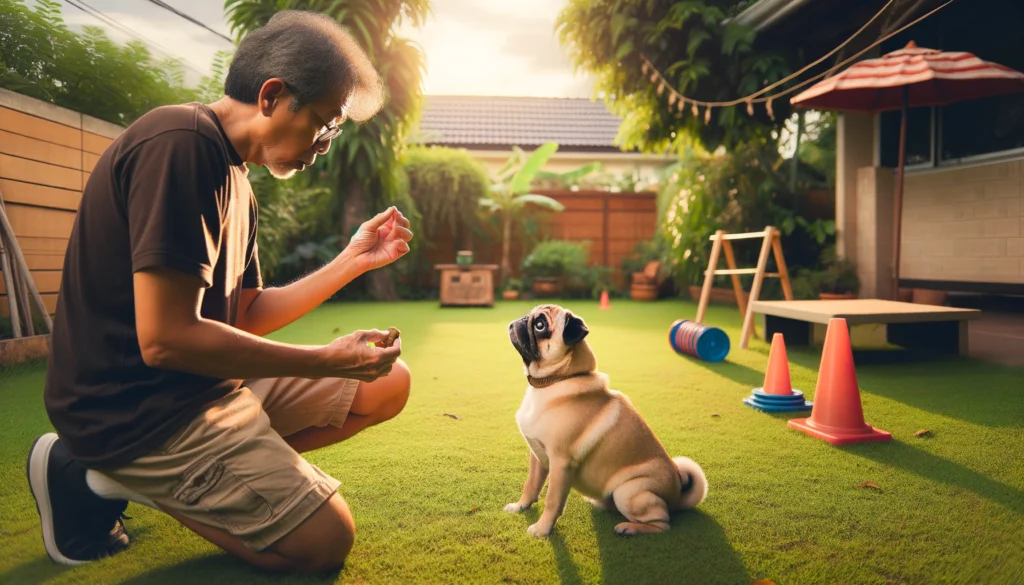
Pug puppy training requires patience. It demands understanding their unique needs. Many have asked, can these charming dogs adapt to outdoor living? The answer isn’t straightforward. For successful outdoor adaptation, setting clear boundaries is vital. We all know pugs possess a distinctive charm coupled with energetic spirits.
Their social nature craves companionship, which makes the training phase crucial. Potty training stands out as a foundational milestone in this journey.
Establishing a routine early on helps. It guides them to understand when and where is appropriate for relieving themselves, especially outdoors. Crate training serves as an excellent method to instill discipline. It carves out a safe haven for them, aiding significantly in this transition.
Moreover, it’s essential to consider their health issues, often genetic faults from selective breeding. Such knowledge informs us about the specific care they require. Ultimately, appreciating their intelligence level plays into how we approach their education.
Crate Training as a Foundation
I discovered that crate training laid a critical foundation for my pug’s journey. This essential aspect of puppy care became indispensable in teaching boundaries and providing a safe space. It turned out, pugs, with their unique blend of affectionate personality and occasional stubbornness, responded well to the structured environment a crate offered.
Every moment spent in crate training was an investment in my pet’s future, fostering a sense of security whether we were focusing on potty training or managing periods I was away.
Combining crate training with consistent, positive reinforcement proved to be a game-changer. It helped address a range of behavioral issues from teething to coping with dog boredom. Meanwhile, ensuring the crate was a welcoming space, equipped with the right dog toys, made all the difference. This approach not only facilitated a smooth transition to indoor living but also prepared us to consider outdoor accommodations safely when the time came.
Can Pugs Live Outside – Dealing with Boredom and Energy
A common misconception held by many is that pugs don’t pack a punch in the energy department. This couldn’t be farther from the truth. Early in their lives, these pups bustle with a type of vigor that surprises most. It’s during these moments, especially in the teething phase, that a challenge arises. Pugs find solace in chewing everything within reach. It serves as their escape from the discomfort of new teeth emerging. Dog toys become invaluable during this period. A variety of chew toys not only soothes their gums but also keeps their mind engaged.
Dog boredom solutions then become a central focus. Imaginative strategies are required to keep their lively minds and bodies stimulated. Activities must evolve beyond the confines of indoor spaces. If a pug finds its way outdoors, engagement is paramount.
Whether it’s exploring new textures in the garden or playing fetch, keeping them entertained outdoors hinges on creativity. This insight guides us in creating an outdoor environment that’s not just safe but enriching for them.
Toys and Engagement Strategies
I’ve found that pugs do require attention and more companionship than other dogs. They thrive on interaction, pointing toward their need for consistent stimulation. Facing the challenges of dog boredom solutions, I discovered that toys play a pivotal role. Not only do they cater to a pug’s playful nature, but they also address the teething phase efficiently.
For us, keeping our pug entertained meant a blend of physical and mental activities. We had to think outside the box. A mixture of puzzles designed for dog breeds, especially those with pug intelligence, became an indispensable part of our routine. These puzzles stimulated their minds, keeping them engaged for longer periods. In tandem, we introduced a variety of dog toys. This variety ensured our pug remained interested and less likely to grow bored with the same old options.
Yet, the essence of pug puppy training extends beyond just toys and games. It encompasses an understanding of their socialization needs, energy levels, and the unique quirks that come with pet care for this loving breed.
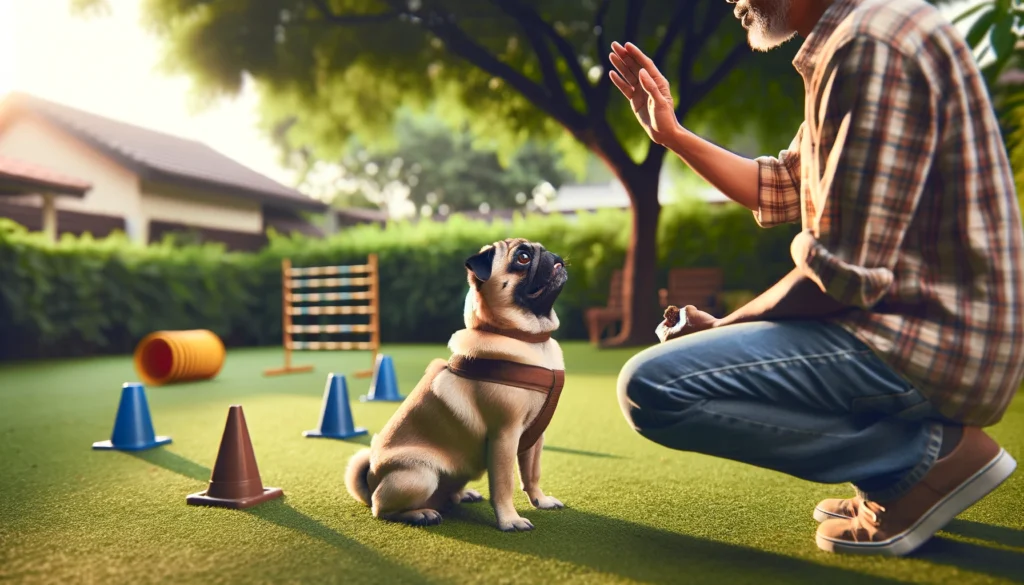
Can Pugs Live Outside – Outdoor Accommodation Tips
Pug puppy training had begged the question, can these compact companions brave the backyard as their mainstay? Advice burgeons on creating an oasis for our pug pals, tailored to ward off the elements. First off, consider a spacious, weather-resistant kennel. This shelter keeps them snug against rain and cozy when the breeze turns brisk. Next, let’s talk comfort. A plush, washable bed inside their haven ensures they laze in luxury between bursts of play.
But the question of safety looms large. Secure fencing is paramount, warding off any unwelcome guests and ensuring your pug doesn’t embark on unsupervised adventures. I’ve heard tales; pugs, despite their stately demeanor, can prove quite the escapists. On the topic of health, regular vet check-ups will preempt any concerns about them thriving outdoors, especially given their unique genetic makeup.
Creating a Safe Outdoor Space
I considered the prospect of my pug embracing the great outdoors with a mix of excitement and caution. Pugs, known for their playful yet clingy nature, posed a unique challenge for outdoor living. They crave companionship and suffer from several health issues, making the task daunting. I gathered advice on creating an outdoor paradise, fit for a pug’s needs.
First, I planned a shelter, mindful of their respiratory challenges and sensitivity to extreme temperatures. The space needed to be cozy and insulated, yet well-ventilated. A sturdy, weather-proof dog house, fitted with a comfortable bed, would protect my pug from rain and sun. I considered temperature control crucial.
On hotter days, a fan or air conditioning unit was to be installed, ensuring my pug stayed cool. I pondered over dog boredom solutions, deciding that an enrichment zone filled with various dog toys would keep my pug entertained.
Lastly, I focused on safety. The outdoor area had to be securely fenced to prevent escapes. By addressing these essentials — shelter, temperature control, and enrichment — I felt confident my pug could enjoy outdoor life without compromising on care or comfort.
Lastly, toys! Ennui can strike the most content of canines. A selection of chew toys, balls, and interactive puzzles keeps their minds sharp and wards off the dreaded boredom. Implementing these strategies could transform your outdoor space into a pug’s paradise, or so I’ve found in my quest to cater to my furry confidant’s every need.
Can Pugs Live Outside – Alternative Options and Considerations
Considering the unique requirements of pugs, they often thrive best in environments tailored to their physical and emotional needs. I’ve learned outdoor living may not suit every pug due to their health issues and need for companionship. For those of us yearning primarily for an outdoor companion, turning our gaze towards breeds known for their adaptability to the outdoors could prove beneficial. Breeds with a heritage of working or living outside, such as some shepherd or hunting dogs, might align more closely with our lifestyles.
Creating a comfortable outdoor space for a dog demands understanding that breed’s specific needs. This consideration is paramount when dealing with pugs, given their genetic faults and notorious respiratory challenges. However, should you decide your heart is set on a pug, incorporating solutions like a well-insulated dog house or a secure puppy playpen can make outdoor moments enjoyable for your pet.
Always remember, the essence of pet care revolves around meshing our companions’ inherent needs with our living situations. This harmony ensures a joyful life together, whether inside or nestled in a sunlit garden.
Choosing the Right Breed
I learned the hard way that not every dog breed fits well with every lifestyle. It wasn’t just about pug puppy training or managing dog energy levels. It involved understanding all nuances, like pug health issues, the specifics of crate training, and how to properly address dog boredom solutions.
I found out that pugs, with their adorable squishy faces, have unique needs. These include pug socialization techniques different from other breeds and special considerations due to their genetic faults in dogs. Their teething and playful dog behavior require careful management with dog toys and affection.
If you envision outdoor dogs romping around your backyard, consider breeds designed for that environment. It dawned on me that pug intelligence and companionship demands might not mesh well with a predominantly outdoor setting.
Every aspect, from pet care to puppy care and understanding dog breeds, plays a pivotal role. I urge you to make an informed decision that aligns with your lifestyle, ensuring a happy life for you and your furry friend.
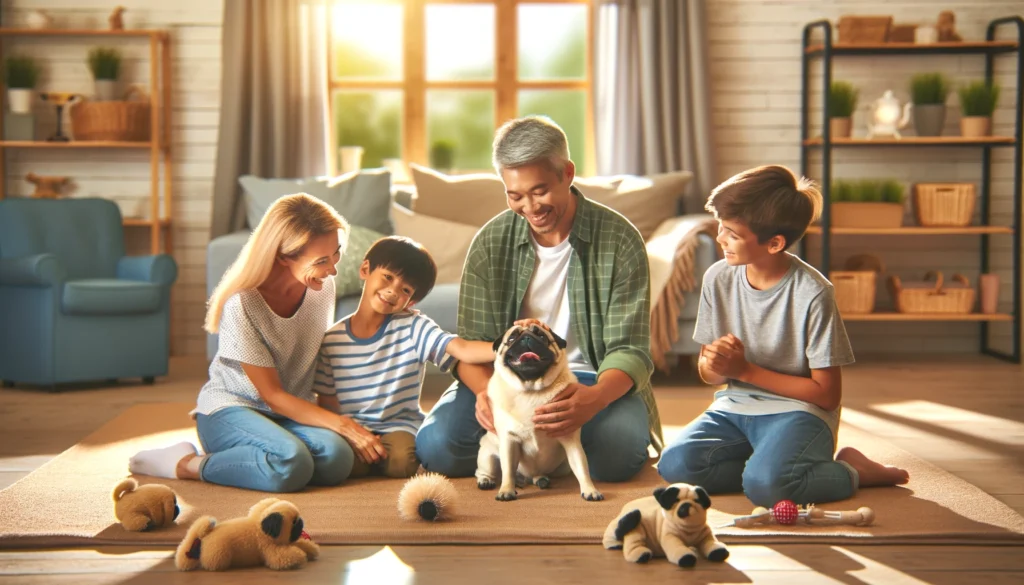
A Pug’s Place is Where the Heart Is
Understanding the unique needs of pugs has led me on an insightful journey. I discovered that pug puppy training is not just about teaching them where to relieve themselves but also about ensuring their well-being, both physically and emotionally. The idea of keeping these affectionate creatures as outdoor dogs raised pivotal discussions about their health issues, need for companionship, and how best to cater to their playful yet delicate nature.
Crate training emerged as a foundational tool, not only for potty training but also for creating a safe haven for our pug friends. This aligns with their need for a secure and comfortable environment that mirrors the warmth and care they receive from us.
Pug socialization was another critical aspect; these dogs crave human interaction and thrive on affection and engagement. The health and genetic considerations, especially those affecting their breathing, were eye-openers, emphasizing why certain environments are better suited for them than others.
Adapting to a pug’s energy levels and finding solutions to curb their boredom became a creative endeavor. From dog toys to engaging playtime, the aim was to ensure they remain active and happy. This brought to light the importance of pet care that goes beyond the basics, addressing the nuanced needs of different dog breeds. The discussions around indoor vs outdoor dogs underscored that while pugs can spend time outside, their place is truly where the heart is – alongside their human companions. Genetic faults in dogs, particularly breeds like pugs, make it imperative to provide a living situation that mitigates any adverse effects.
In sum, while pugs might adapt to outdoor living under certain conditions, their health, happiness, and overall well-being are significantly improved when they’re near us. Whether it’s through puppy care, understanding dog behavior, or simply ensuring they are part of our daily lives, pugs indeed flourish best in environments filled with love, care, and companionship.

